Business Environment Analysis of UK Retail Sector: Report
VerifiedAdded on 2020/07/22
|15
|4678
|102
Report
AI Summary
This report provides a comprehensive analysis of the business environment within the UK retail sector, focusing on key players like Tesco, Marks & Spencer, Asda, and Sainsbury's. It begins by defining the business environment and then delves into different types of organizations, including profit, non-profit, public, private, and voluntary sectors, and examines their respective purposes. The report explores the size and scope of organizations (micro, small, medium, and large) and how these factors are linked to business objectives. It also analyzes organizational structures and functions, discussing the merits and demerits of their interrelationships. Furthermore, the report applies the PESTLE model to identify the positive and negative impacts of macro factors on the retail sector, followed by SWOT and five forces analyses to determine strengths, weaknesses, and their relationships with external macro forces. The study critically evaluates the impact of environmental factors on business objectives and decision-making, concluding with a summary of the findings and references.
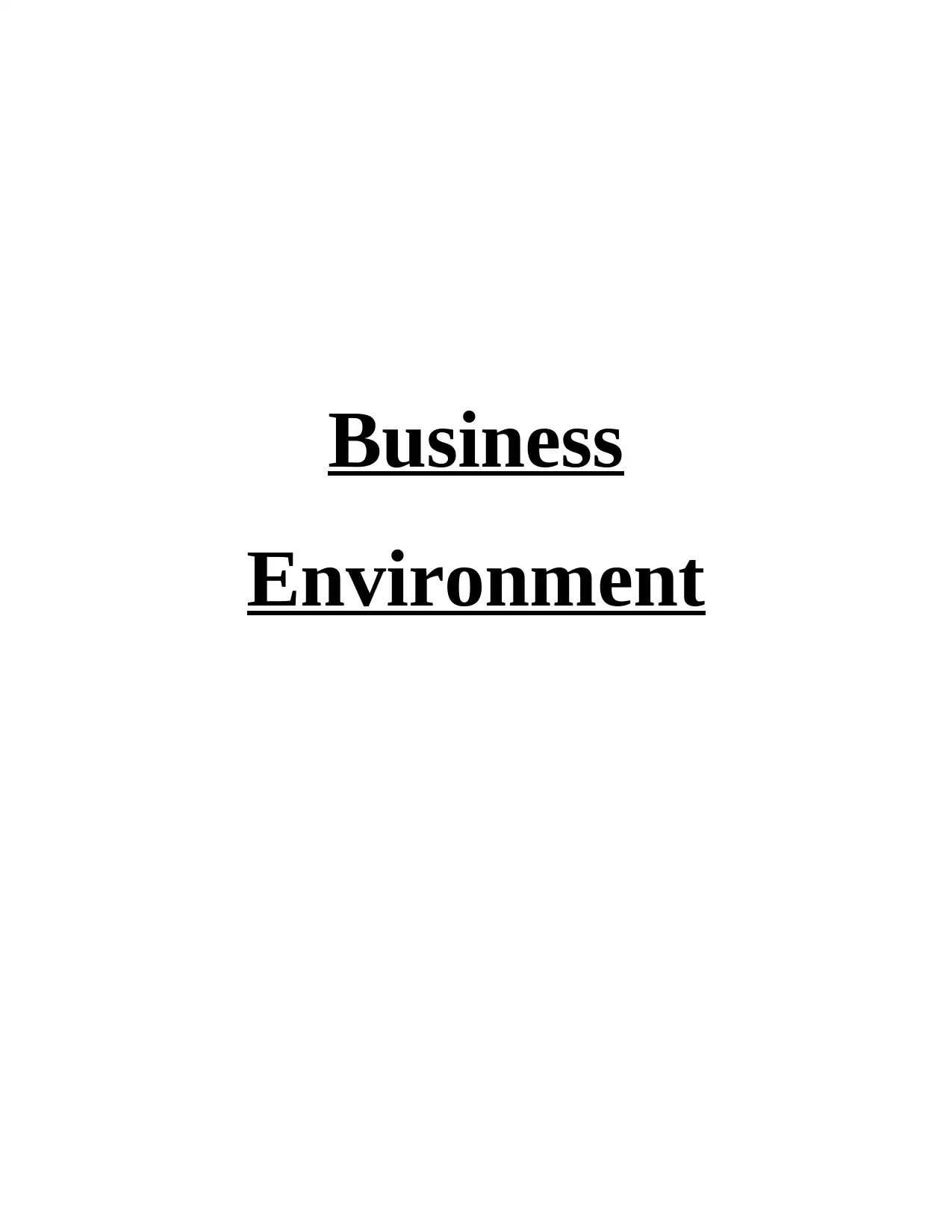
Business
Environment
Environment
Paraphrase This Document
Need a fresh take? Get an instant paraphrase of this document with our AI Paraphraser
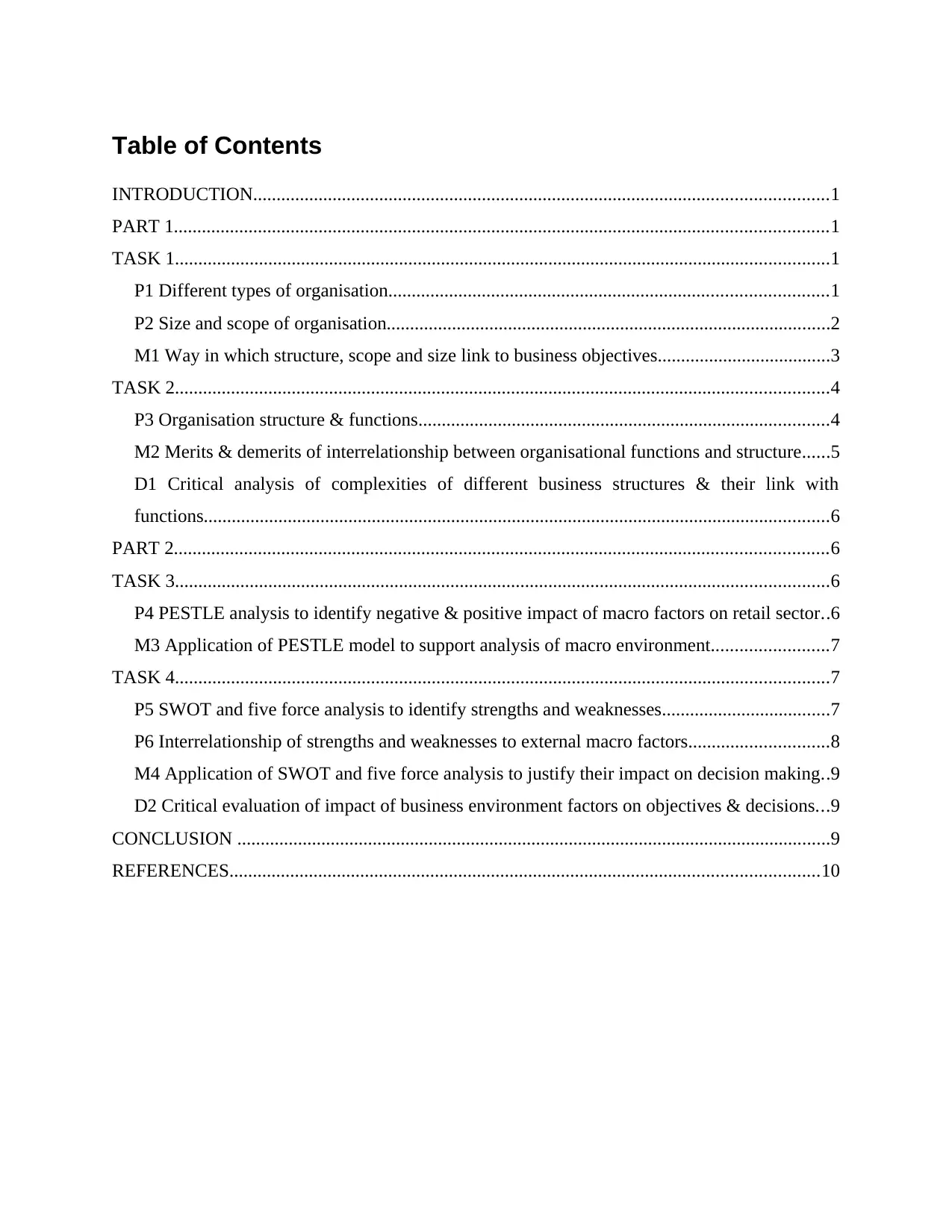
Table of Contents
INTRODUCTION...........................................................................................................................1
PART 1............................................................................................................................................1
TASK 1............................................................................................................................................1
P1 Different types of organisation..............................................................................................1
P2 Size and scope of organisation...............................................................................................2
M1 Way in which structure, scope and size link to business objectives.....................................3
TASK 2............................................................................................................................................4
P3 Organisation structure & functions........................................................................................4
M2 Merits & demerits of interrelationship between organisational functions and structure......5
D1 Critical analysis of complexities of different business structures & their link with
functions......................................................................................................................................6
PART 2............................................................................................................................................6
TASK 3............................................................................................................................................6
P4 PESTLE analysis to identify negative & positive impact of macro factors on retail sector..6
M3 Application of PESTLE model to support analysis of macro environment.........................7
TASK 4............................................................................................................................................7
P5 SWOT and five force analysis to identify strengths and weaknesses....................................7
P6 Interrelationship of strengths and weaknesses to external macro factors..............................8
M4 Application of SWOT and five force analysis to justify their impact on decision making..9
D2 Critical evaluation of impact of business environment factors on objectives & decisions...9
CONCLUSION ...............................................................................................................................9
REFERENCES..............................................................................................................................10
INTRODUCTION...........................................................................................................................1
PART 1............................................................................................................................................1
TASK 1............................................................................................................................................1
P1 Different types of organisation..............................................................................................1
P2 Size and scope of organisation...............................................................................................2
M1 Way in which structure, scope and size link to business objectives.....................................3
TASK 2............................................................................................................................................4
P3 Organisation structure & functions........................................................................................4
M2 Merits & demerits of interrelationship between organisational functions and structure......5
D1 Critical analysis of complexities of different business structures & their link with
functions......................................................................................................................................6
PART 2............................................................................................................................................6
TASK 3............................................................................................................................................6
P4 PESTLE analysis to identify negative & positive impact of macro factors on retail sector..6
M3 Application of PESTLE model to support analysis of macro environment.........................7
TASK 4............................................................................................................................................7
P5 SWOT and five force analysis to identify strengths and weaknesses....................................7
P6 Interrelationship of strengths and weaknesses to external macro factors..............................8
M4 Application of SWOT and five force analysis to justify their impact on decision making..9
D2 Critical evaluation of impact of business environment factors on objectives & decisions...9
CONCLUSION ...............................................................................................................................9
REFERENCES..............................................................................................................................10
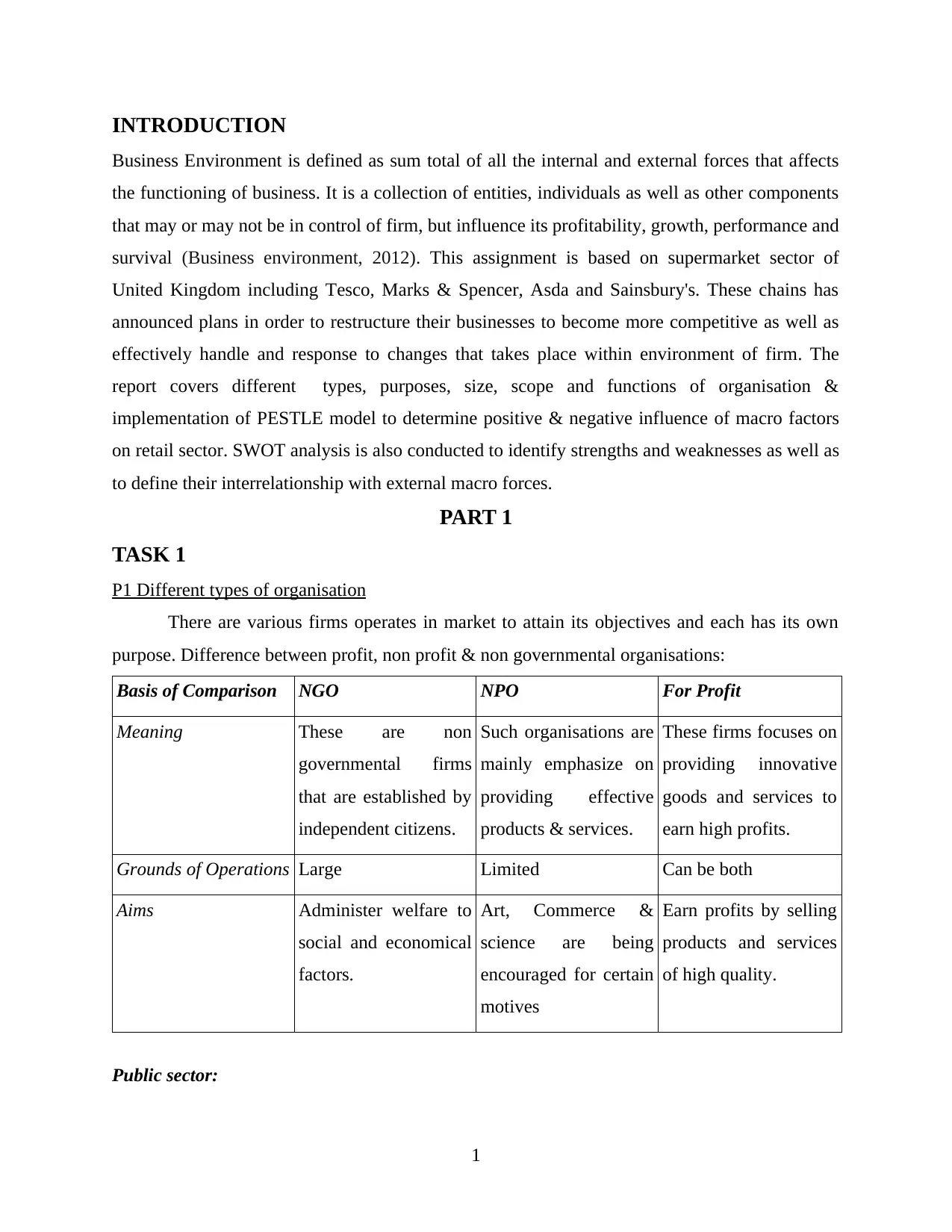
INTRODUCTION
Business Environment is defined as sum total of all the internal and external forces that affects
the functioning of business. It is a collection of entities, individuals as well as other components
that may or may not be in control of firm, but influence its profitability, growth, performance and
survival (Business environment, 2012). This assignment is based on supermarket sector of
United Kingdom including Tesco, Marks & Spencer, Asda and Sainsbury's. These chains has
announced plans in order to restructure their businesses to become more competitive as well as
effectively handle and response to changes that takes place within environment of firm. The
report covers different types, purposes, size, scope and functions of organisation &
implementation of PESTLE model to determine positive & negative influence of macro factors
on retail sector. SWOT analysis is also conducted to identify strengths and weaknesses as well as
to define their interrelationship with external macro forces.
PART 1
TASK 1
P1 Different types of organisation
There are various firms operates in market to attain its objectives and each has its own
purpose. Difference between profit, non profit & non governmental organisations:
Basis of Comparison NGO NPO For Profit
Meaning These are non
governmental firms
that are established by
independent citizens.
Such organisations are
mainly emphasize on
providing effective
products & services.
These firms focuses on
providing innovative
goods and services to
earn high profits.
Grounds of Operations Large Limited Can be both
Aims Administer welfare to
social and economical
factors.
Art, Commerce &
science are being
encouraged for certain
motives
Earn profits by selling
products and services
of high quality.
Public sector:
1
Business Environment is defined as sum total of all the internal and external forces that affects
the functioning of business. It is a collection of entities, individuals as well as other components
that may or may not be in control of firm, but influence its profitability, growth, performance and
survival (Business environment, 2012). This assignment is based on supermarket sector of
United Kingdom including Tesco, Marks & Spencer, Asda and Sainsbury's. These chains has
announced plans in order to restructure their businesses to become more competitive as well as
effectively handle and response to changes that takes place within environment of firm. The
report covers different types, purposes, size, scope and functions of organisation &
implementation of PESTLE model to determine positive & negative influence of macro factors
on retail sector. SWOT analysis is also conducted to identify strengths and weaknesses as well as
to define their interrelationship with external macro forces.
PART 1
TASK 1
P1 Different types of organisation
There are various firms operates in market to attain its objectives and each has its own
purpose. Difference between profit, non profit & non governmental organisations:
Basis of Comparison NGO NPO For Profit
Meaning These are non
governmental firms
that are established by
independent citizens.
Such organisations are
mainly emphasize on
providing effective
products & services.
These firms focuses on
providing innovative
goods and services to
earn high profits.
Grounds of Operations Large Limited Can be both
Aims Administer welfare to
social and economical
factors.
Art, Commerce &
science are being
encouraged for certain
motives
Earn profits by selling
products and services
of high quality.
Public sector:
1
⊘ This is a preview!⊘
Do you want full access?
Subscribe today to unlock all pages.

Trusted by 1+ million students worldwide
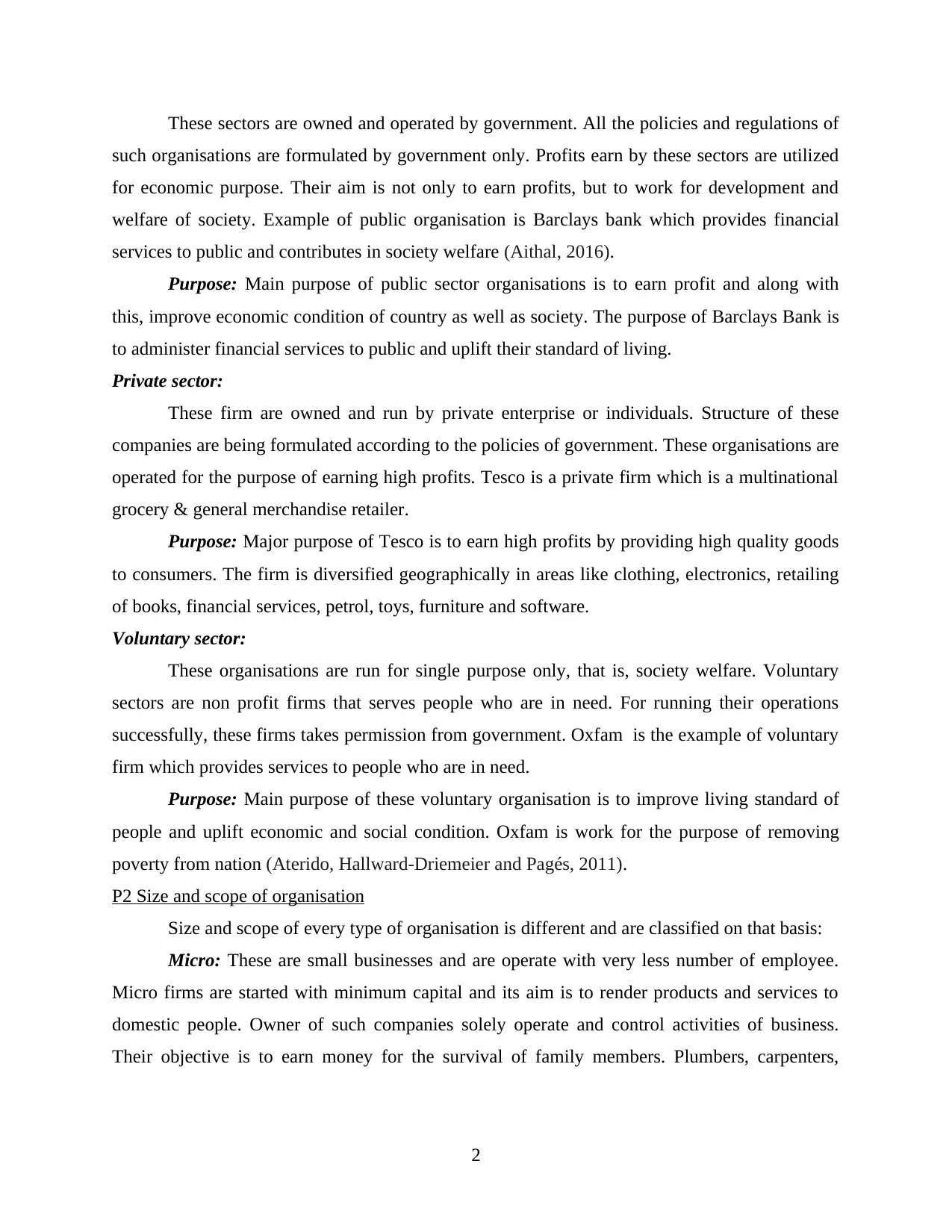
These sectors are owned and operated by government. All the policies and regulations of
such organisations are formulated by government only. Profits earn by these sectors are utilized
for economic purpose. Their aim is not only to earn profits, but to work for development and
welfare of society. Example of public organisation is Barclays bank which provides financial
services to public and contributes in society welfare (Aithal, 2016).
Purpose: Main purpose of public sector organisations is to earn profit and along with
this, improve economic condition of country as well as society. The purpose of Barclays Bank is
to administer financial services to public and uplift their standard of living.
Private sector:
These firm are owned and run by private enterprise or individuals. Structure of these
companies are being formulated according to the policies of government. These organisations are
operated for the purpose of earning high profits. Tesco is a private firm which is a multinational
grocery & general merchandise retailer.
Purpose: Major purpose of Tesco is to earn high profits by providing high quality goods
to consumers. The firm is diversified geographically in areas like clothing, electronics, retailing
of books, financial services, petrol, toys, furniture and software.
Voluntary sector:
These organisations are run for single purpose only, that is, society welfare. Voluntary
sectors are non profit firms that serves people who are in need. For running their operations
successfully, these firms takes permission from government. Oxfam is the example of voluntary
firm which provides services to people who are in need.
Purpose: Main purpose of these voluntary organisation is to improve living standard of
people and uplift economic and social condition. Oxfam is work for the purpose of removing
poverty from nation (Aterido, Hallward-Driemeier and Pagés, 2011).
P2 Size and scope of organisation
Size and scope of every type of organisation is different and are classified on that basis:
Micro: These are small businesses and are operate with very less number of employee.
Micro firms are started with minimum capital and its aim is to render products and services to
domestic people. Owner of such companies solely operate and control activities of business.
Their objective is to earn money for the survival of family members. Plumbers, carpenters,
2
such organisations are formulated by government only. Profits earn by these sectors are utilized
for economic purpose. Their aim is not only to earn profits, but to work for development and
welfare of society. Example of public organisation is Barclays bank which provides financial
services to public and contributes in society welfare (Aithal, 2016).
Purpose: Main purpose of public sector organisations is to earn profit and along with
this, improve economic condition of country as well as society. The purpose of Barclays Bank is
to administer financial services to public and uplift their standard of living.
Private sector:
These firm are owned and run by private enterprise or individuals. Structure of these
companies are being formulated according to the policies of government. These organisations are
operated for the purpose of earning high profits. Tesco is a private firm which is a multinational
grocery & general merchandise retailer.
Purpose: Major purpose of Tesco is to earn high profits by providing high quality goods
to consumers. The firm is diversified geographically in areas like clothing, electronics, retailing
of books, financial services, petrol, toys, furniture and software.
Voluntary sector:
These organisations are run for single purpose only, that is, society welfare. Voluntary
sectors are non profit firms that serves people who are in need. For running their operations
successfully, these firms takes permission from government. Oxfam is the example of voluntary
firm which provides services to people who are in need.
Purpose: Main purpose of these voluntary organisation is to improve living standard of
people and uplift economic and social condition. Oxfam is work for the purpose of removing
poverty from nation (Aterido, Hallward-Driemeier and Pagés, 2011).
P2 Size and scope of organisation
Size and scope of every type of organisation is different and are classified on that basis:
Micro: These are small businesses and are operate with very less number of employee.
Micro firms are started with minimum capital and its aim is to render products and services to
domestic people. Owner of such companies solely operate and control activities of business.
Their objective is to earn money for the survival of family members. Plumbers, carpenters,
2
Paraphrase This Document
Need a fresh take? Get an instant paraphrase of this document with our AI Paraphraser
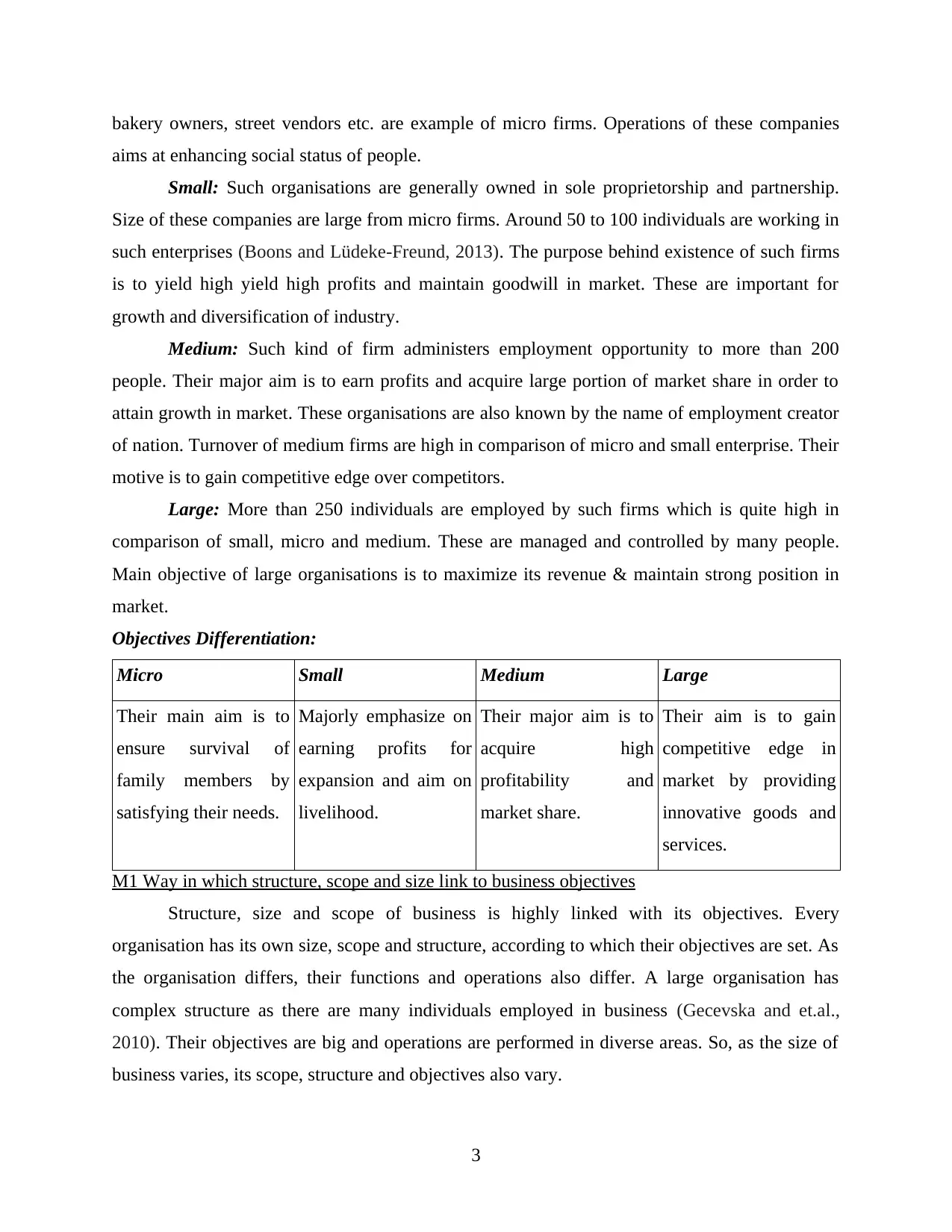
bakery owners, street vendors etc. are example of micro firms. Operations of these companies
aims at enhancing social status of people.
Small: Such organisations are generally owned in sole proprietorship and partnership.
Size of these companies are large from micro firms. Around 50 to 100 individuals are working in
such enterprises (Boons and Lüdeke-Freund, 2013). The purpose behind existence of such firms
is to yield high yield high profits and maintain goodwill in market. These are important for
growth and diversification of industry.
Medium: Such kind of firm administers employment opportunity to more than 200
people. Their major aim is to earn profits and acquire large portion of market share in order to
attain growth in market. These organisations are also known by the name of employment creator
of nation. Turnover of medium firms are high in comparison of micro and small enterprise. Their
motive is to gain competitive edge over competitors.
Large: More than 250 individuals are employed by such firms which is quite high in
comparison of small, micro and medium. These are managed and controlled by many people.
Main objective of large organisations is to maximize its revenue & maintain strong position in
market.
Objectives Differentiation:
Micro Small Medium Large
Their main aim is to
ensure survival of
family members by
satisfying their needs.
Majorly emphasize on
earning profits for
expansion and aim on
livelihood.
Their major aim is to
acquire high
profitability and
market share.
Their aim is to gain
competitive edge in
market by providing
innovative goods and
services.
M1 Way in which structure, scope and size link to business objectives
Structure, size and scope of business is highly linked with its objectives. Every
organisation has its own size, scope and structure, according to which their objectives are set. As
the organisation differs, their functions and operations also differ. A large organisation has
complex structure as there are many individuals employed in business (Gecevska and et.al.,
2010). Their objectives are big and operations are performed in diverse areas. So, as the size of
business varies, its scope, structure and objectives also vary.
3
aims at enhancing social status of people.
Small: Such organisations are generally owned in sole proprietorship and partnership.
Size of these companies are large from micro firms. Around 50 to 100 individuals are working in
such enterprises (Boons and Lüdeke-Freund, 2013). The purpose behind existence of such firms
is to yield high yield high profits and maintain goodwill in market. These are important for
growth and diversification of industry.
Medium: Such kind of firm administers employment opportunity to more than 200
people. Their major aim is to earn profits and acquire large portion of market share in order to
attain growth in market. These organisations are also known by the name of employment creator
of nation. Turnover of medium firms are high in comparison of micro and small enterprise. Their
motive is to gain competitive edge over competitors.
Large: More than 250 individuals are employed by such firms which is quite high in
comparison of small, micro and medium. These are managed and controlled by many people.
Main objective of large organisations is to maximize its revenue & maintain strong position in
market.
Objectives Differentiation:
Micro Small Medium Large
Their main aim is to
ensure survival of
family members by
satisfying their needs.
Majorly emphasize on
earning profits for
expansion and aim on
livelihood.
Their major aim is to
acquire high
profitability and
market share.
Their aim is to gain
competitive edge in
market by providing
innovative goods and
services.
M1 Way in which structure, scope and size link to business objectives
Structure, size and scope of business is highly linked with its objectives. Every
organisation has its own size, scope and structure, according to which their objectives are set. As
the organisation differs, their functions and operations also differ. A large organisation has
complex structure as there are many individuals employed in business (Gecevska and et.al.,
2010). Their objectives are big and operations are performed in diverse areas. So, as the size of
business varies, its scope, structure and objectives also vary.
3
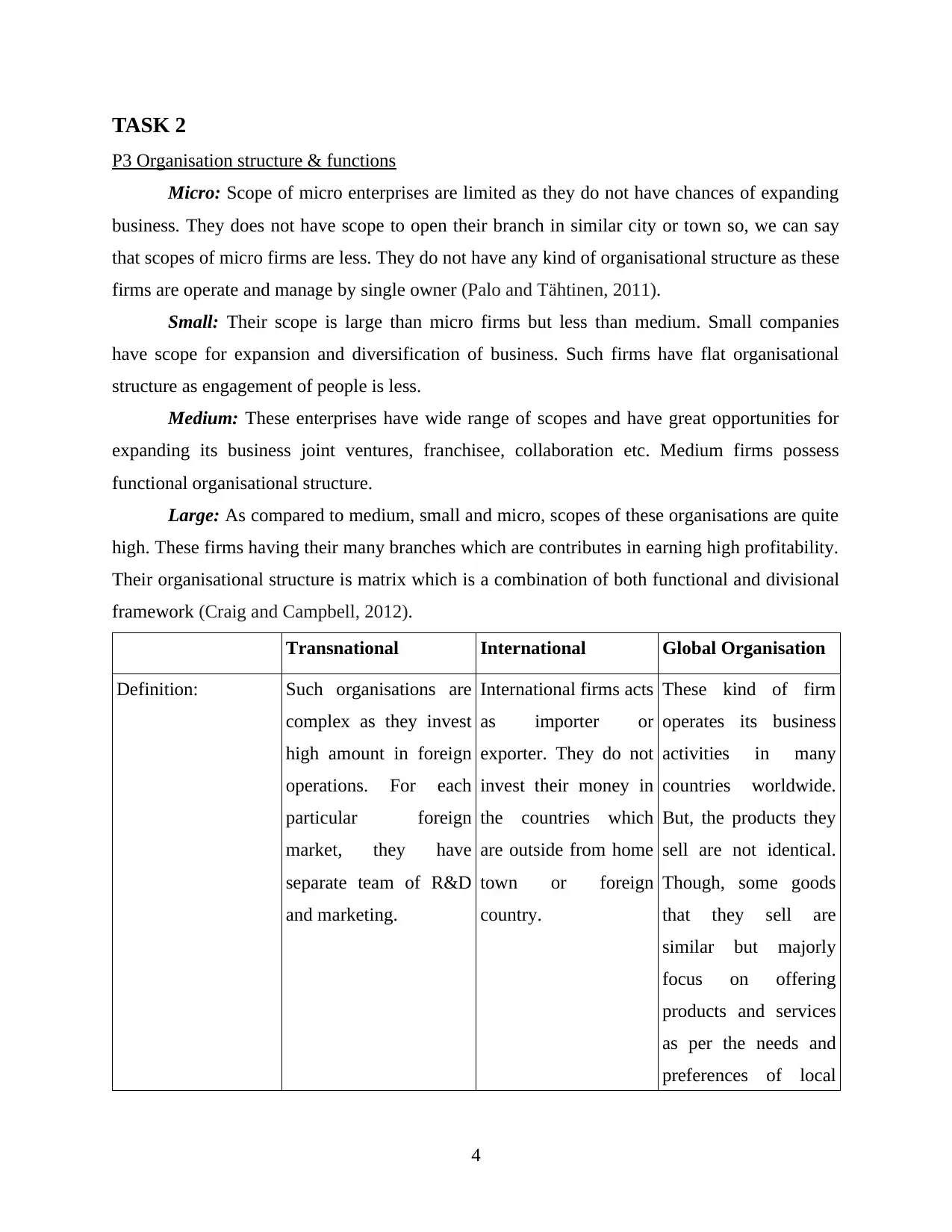
TASK 2
P3 Organisation structure & functions
Micro: Scope of micro enterprises are limited as they do not have chances of expanding
business. They does not have scope to open their branch in similar city or town so, we can say
that scopes of micro firms are less. They do not have any kind of organisational structure as these
firms are operate and manage by single owner (Palo and Tähtinen, 2011).
Small: Their scope is large than micro firms but less than medium. Small companies
have scope for expansion and diversification of business. Such firms have flat organisational
structure as engagement of people is less.
Medium: These enterprises have wide range of scopes and have great opportunities for
expanding its business joint ventures, franchisee, collaboration etc. Medium firms possess
functional organisational structure.
Large: As compared to medium, small and micro, scopes of these organisations are quite
high. These firms having their many branches which are contributes in earning high profitability.
Their organisational structure is matrix which is a combination of both functional and divisional
framework (Craig and Campbell, 2012).
Transnational International Global Organisation
Definition: Such organisations are
complex as they invest
high amount in foreign
operations. For each
particular foreign
market, they have
separate team of R&D
and marketing.
International firms acts
as importer or
exporter. They do not
invest their money in
the countries which
are outside from home
town or foreign
country.
These kind of firm
operates its business
activities in many
countries worldwide.
But, the products they
sell are not identical.
Though, some goods
that they sell are
similar but majorly
focus on offering
products and services
as per the needs and
preferences of local
4
P3 Organisation structure & functions
Micro: Scope of micro enterprises are limited as they do not have chances of expanding
business. They does not have scope to open their branch in similar city or town so, we can say
that scopes of micro firms are less. They do not have any kind of organisational structure as these
firms are operate and manage by single owner (Palo and Tähtinen, 2011).
Small: Their scope is large than micro firms but less than medium. Small companies
have scope for expansion and diversification of business. Such firms have flat organisational
structure as engagement of people is less.
Medium: These enterprises have wide range of scopes and have great opportunities for
expanding its business joint ventures, franchisee, collaboration etc. Medium firms possess
functional organisational structure.
Large: As compared to medium, small and micro, scopes of these organisations are quite
high. These firms having their many branches which are contributes in earning high profitability.
Their organisational structure is matrix which is a combination of both functional and divisional
framework (Craig and Campbell, 2012).
Transnational International Global Organisation
Definition: Such organisations are
complex as they invest
high amount in foreign
operations. For each
particular foreign
market, they have
separate team of R&D
and marketing.
International firms acts
as importer or
exporter. They do not
invest their money in
the countries which
are outside from home
town or foreign
country.
These kind of firm
operates its business
activities in many
countries worldwide.
But, the products they
sell are not identical.
Though, some goods
that they sell are
similar but majorly
focus on offering
products and services
as per the needs and
preferences of local
4
⊘ This is a preview!⊘
Do you want full access?
Subscribe today to unlock all pages.

Trusted by 1+ million students worldwide
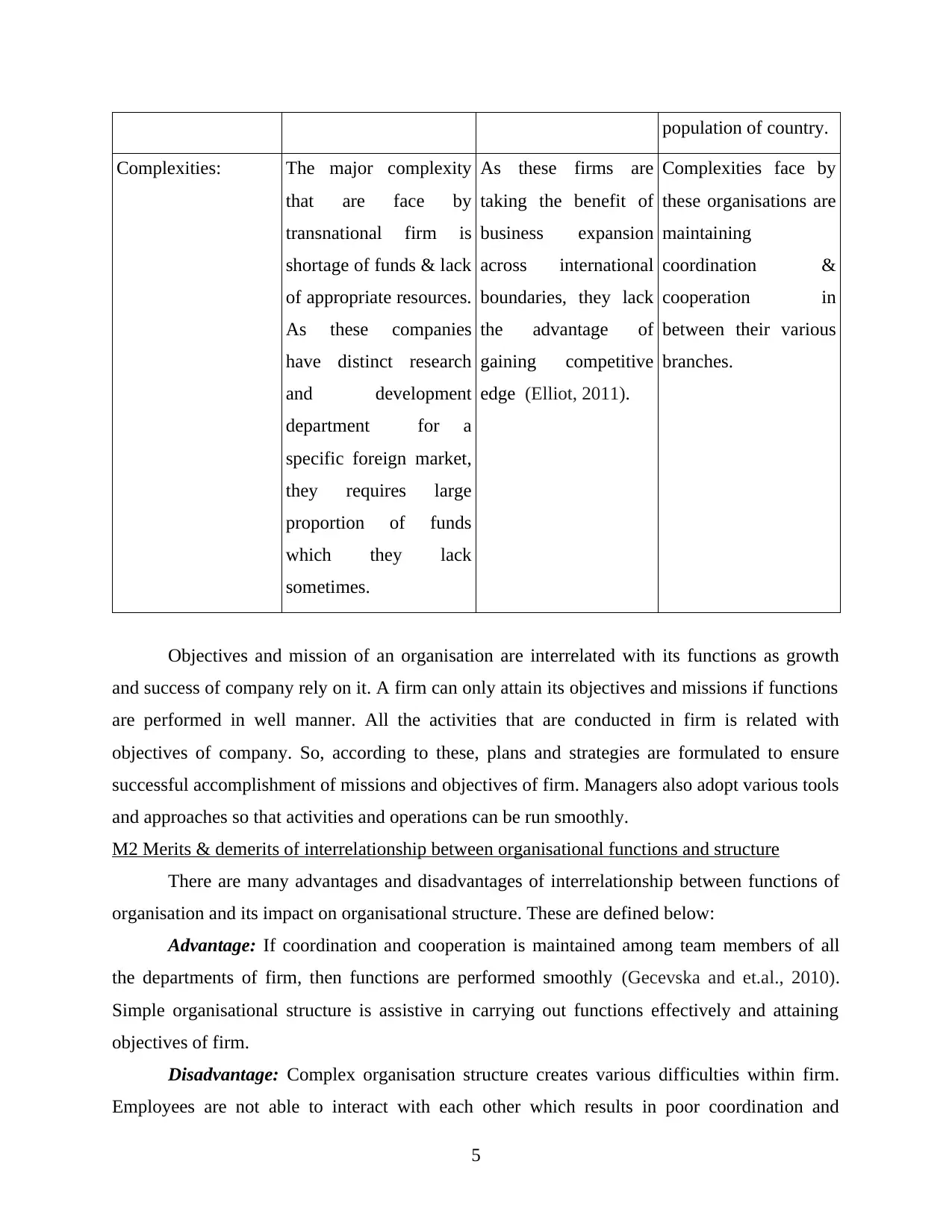
population of country.
Complexities: The major complexity
that are face by
transnational firm is
shortage of funds & lack
of appropriate resources.
As these companies
have distinct research
and development
department for a
specific foreign market,
they requires large
proportion of funds
which they lack
sometimes.
As these firms are
taking the benefit of
business expansion
across international
boundaries, they lack
the advantage of
gaining competitive
edge (Elliot, 2011).
Complexities face by
these organisations are
maintaining
coordination &
cooperation in
between their various
branches.
Objectives and mission of an organisation are interrelated with its functions as growth
and success of company rely on it. A firm can only attain its objectives and missions if functions
are performed in well manner. All the activities that are conducted in firm is related with
objectives of company. So, according to these, plans and strategies are formulated to ensure
successful accomplishment of missions and objectives of firm. Managers also adopt various tools
and approaches so that activities and operations can be run smoothly.
M2 Merits & demerits of interrelationship between organisational functions and structure
There are many advantages and disadvantages of interrelationship between functions of
organisation and its impact on organisational structure. These are defined below:
Advantage: If coordination and cooperation is maintained among team members of all
the departments of firm, then functions are performed smoothly (Gecevska and et.al., 2010).
Simple organisational structure is assistive in carrying out functions effectively and attaining
objectives of firm.
Disadvantage: Complex organisation structure creates various difficulties within firm.
Employees are not able to interact with each other which results in poor coordination and
5
Complexities: The major complexity
that are face by
transnational firm is
shortage of funds & lack
of appropriate resources.
As these companies
have distinct research
and development
department for a
specific foreign market,
they requires large
proportion of funds
which they lack
sometimes.
As these firms are
taking the benefit of
business expansion
across international
boundaries, they lack
the advantage of
gaining competitive
edge (Elliot, 2011).
Complexities face by
these organisations are
maintaining
coordination &
cooperation in
between their various
branches.
Objectives and mission of an organisation are interrelated with its functions as growth
and success of company rely on it. A firm can only attain its objectives and missions if functions
are performed in well manner. All the activities that are conducted in firm is related with
objectives of company. So, according to these, plans and strategies are formulated to ensure
successful accomplishment of missions and objectives of firm. Managers also adopt various tools
and approaches so that activities and operations can be run smoothly.
M2 Merits & demerits of interrelationship between organisational functions and structure
There are many advantages and disadvantages of interrelationship between functions of
organisation and its impact on organisational structure. These are defined below:
Advantage: If coordination and cooperation is maintained among team members of all
the departments of firm, then functions are performed smoothly (Gecevska and et.al., 2010).
Simple organisational structure is assistive in carrying out functions effectively and attaining
objectives of firm.
Disadvantage: Complex organisation structure creates various difficulties within firm.
Employees are not able to interact with each other which results in poor coordination and
5
Paraphrase This Document
Need a fresh take? Get an instant paraphrase of this document with our AI Paraphraser
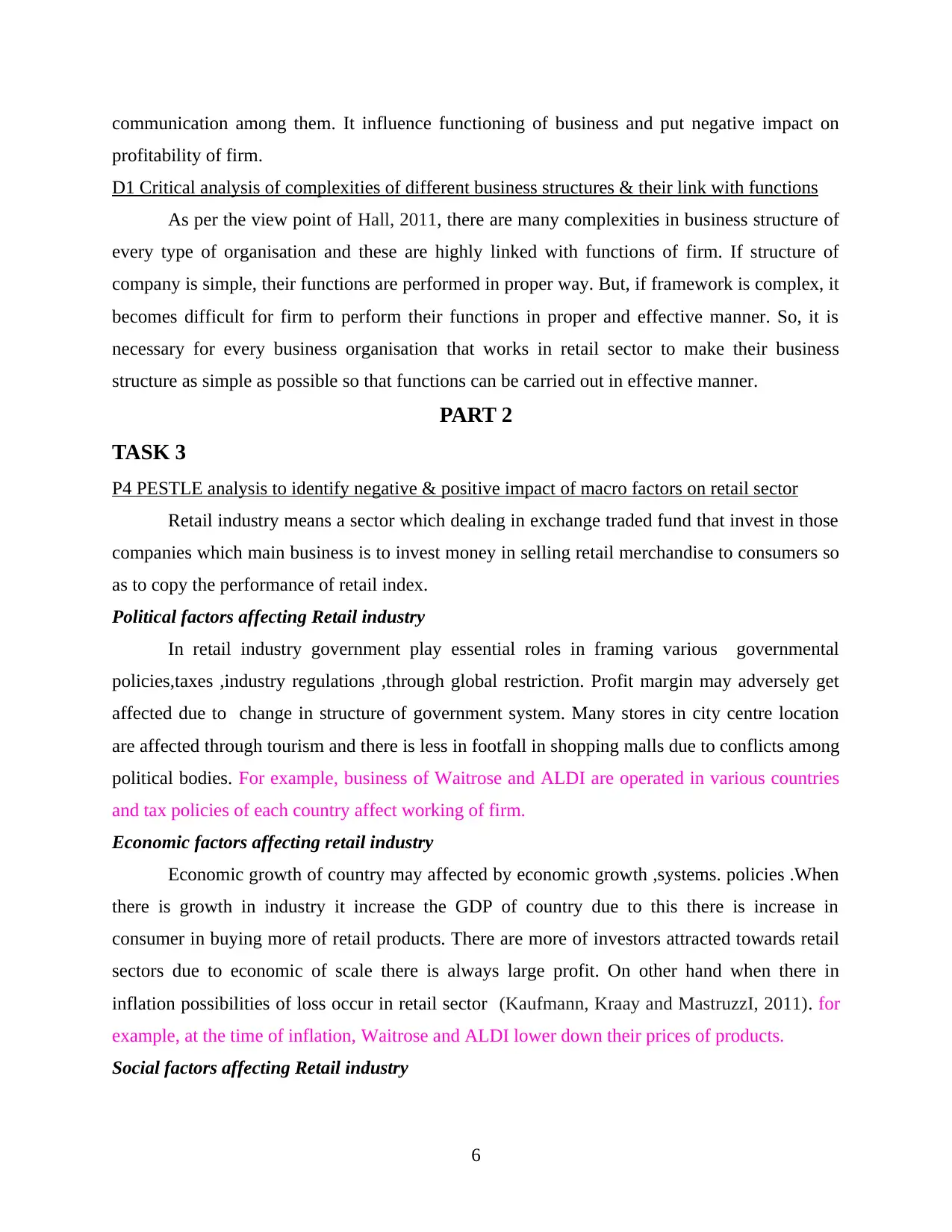
communication among them. It influence functioning of business and put negative impact on
profitability of firm.
D1 Critical analysis of complexities of different business structures & their link with functions
As per the view point of Hall, 2011, there are many complexities in business structure of
every type of organisation and these are highly linked with functions of firm. If structure of
company is simple, their functions are performed in proper way. But, if framework is complex, it
becomes difficult for firm to perform their functions in proper and effective manner. So, it is
necessary for every business organisation that works in retail sector to make their business
structure as simple as possible so that functions can be carried out in effective manner.
PART 2
TASK 3
P4 PESTLE analysis to identify negative & positive impact of macro factors on retail sector
Retail industry means a sector which dealing in exchange traded fund that invest in those
companies which main business is to invest money in selling retail merchandise to consumers so
as to copy the performance of retail index.
Political factors affecting Retail industry
In retail industry government play essential roles in framing various governmental
policies,taxes ,industry regulations ,through global restriction. Profit margin may adversely get
affected due to change in structure of government system. Many stores in city centre location
are affected through tourism and there is less in footfall in shopping malls due to conflicts among
political bodies. For example, business of Waitrose and ALDI are operated in various countries
and tax policies of each country affect working of firm.
Economic factors affecting retail industry
Economic growth of country may affected by economic growth ,systems. policies .When
there is growth in industry it increase the GDP of country due to this there is increase in
consumer in buying more of retail products. There are more of investors attracted towards retail
sectors due to economic of scale there is always large profit. On other hand when there in
inflation possibilities of loss occur in retail sector (Kaufmann, Kraay and MastruzzI, 2011). for
example, at the time of inflation, Waitrose and ALDI lower down their prices of products.
Social factors affecting Retail industry
6
profitability of firm.
D1 Critical analysis of complexities of different business structures & their link with functions
As per the view point of Hall, 2011, there are many complexities in business structure of
every type of organisation and these are highly linked with functions of firm. If structure of
company is simple, their functions are performed in proper way. But, if framework is complex, it
becomes difficult for firm to perform their functions in proper and effective manner. So, it is
necessary for every business organisation that works in retail sector to make their business
structure as simple as possible so that functions can be carried out in effective manner.
PART 2
TASK 3
P4 PESTLE analysis to identify negative & positive impact of macro factors on retail sector
Retail industry means a sector which dealing in exchange traded fund that invest in those
companies which main business is to invest money in selling retail merchandise to consumers so
as to copy the performance of retail index.
Political factors affecting Retail industry
In retail industry government play essential roles in framing various governmental
policies,taxes ,industry regulations ,through global restriction. Profit margin may adversely get
affected due to change in structure of government system. Many stores in city centre location
are affected through tourism and there is less in footfall in shopping malls due to conflicts among
political bodies. For example, business of Waitrose and ALDI are operated in various countries
and tax policies of each country affect working of firm.
Economic factors affecting retail industry
Economic growth of country may affected by economic growth ,systems. policies .When
there is growth in industry it increase the GDP of country due to this there is increase in
consumer in buying more of retail products. There are more of investors attracted towards retail
sectors due to economic of scale there is always large profit. On other hand when there in
inflation possibilities of loss occur in retail sector (Kaufmann, Kraay and MastruzzI, 2011). for
example, at the time of inflation, Waitrose and ALDI lower down their prices of products.
Social factors affecting Retail industry
6
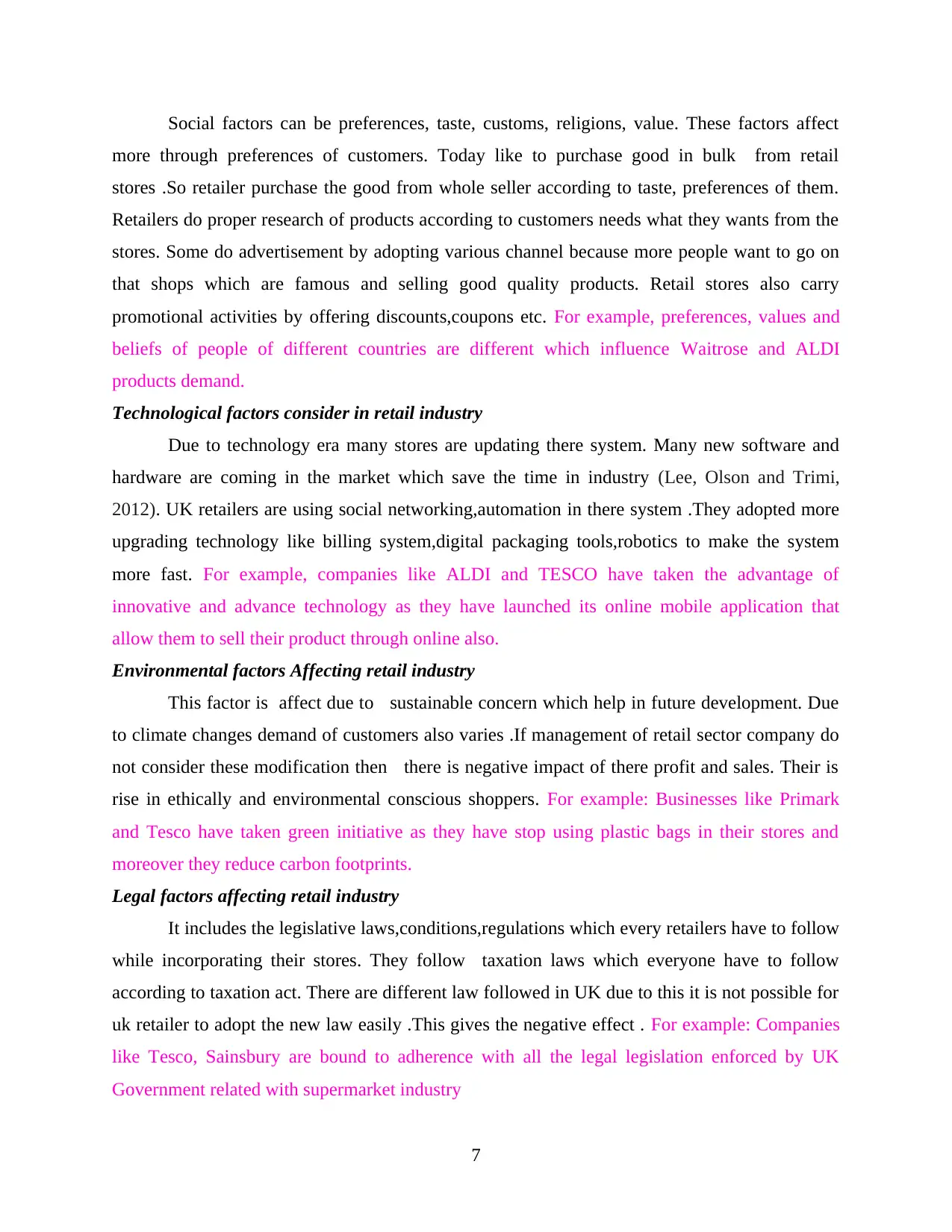
Social factors can be preferences, taste, customs, religions, value. These factors affect
more through preferences of customers. Today like to purchase good in bulk from retail
stores .So retailer purchase the good from whole seller according to taste, preferences of them.
Retailers do proper research of products according to customers needs what they wants from the
stores. Some do advertisement by adopting various channel because more people want to go on
that shops which are famous and selling good quality products. Retail stores also carry
promotional activities by offering discounts,coupons etc. For example, preferences, values and
beliefs of people of different countries are different which influence Waitrose and ALDI
products demand.
Technological factors consider in retail industry
Due to technology era many stores are updating there system. Many new software and
hardware are coming in the market which save the time in industry (Lee, Olson and Trimi,
2012). UK retailers are using social networking,automation in there system .They adopted more
upgrading technology like billing system,digital packaging tools,robotics to make the system
more fast. For example, companies like ALDI and TESCO have taken the advantage of
innovative and advance technology as they have launched its online mobile application that
allow them to sell their product through online also.
Environmental factors Affecting retail industry
This factor is affect due to sustainable concern which help in future development. Due
to climate changes demand of customers also varies .If management of retail sector company do
not consider these modification then there is negative impact of there profit and sales. Their is
rise in ethically and environmental conscious shoppers. For example: Businesses like Primark
and Tesco have taken green initiative as they have stop using plastic bags in their stores and
moreover they reduce carbon footprints.
Legal factors affecting retail industry
It includes the legislative laws,conditions,regulations which every retailers have to follow
while incorporating their stores. They follow taxation laws which everyone have to follow
according to taxation act. There are different law followed in UK due to this it is not possible for
uk retailer to adopt the new law easily .This gives the negative effect . For example: Companies
like Tesco, Sainsbury are bound to adherence with all the legal legislation enforced by UK
Government related with supermarket industry
7
more through preferences of customers. Today like to purchase good in bulk from retail
stores .So retailer purchase the good from whole seller according to taste, preferences of them.
Retailers do proper research of products according to customers needs what they wants from the
stores. Some do advertisement by adopting various channel because more people want to go on
that shops which are famous and selling good quality products. Retail stores also carry
promotional activities by offering discounts,coupons etc. For example, preferences, values and
beliefs of people of different countries are different which influence Waitrose and ALDI
products demand.
Technological factors consider in retail industry
Due to technology era many stores are updating there system. Many new software and
hardware are coming in the market which save the time in industry (Lee, Olson and Trimi,
2012). UK retailers are using social networking,automation in there system .They adopted more
upgrading technology like billing system,digital packaging tools,robotics to make the system
more fast. For example, companies like ALDI and TESCO have taken the advantage of
innovative and advance technology as they have launched its online mobile application that
allow them to sell their product through online also.
Environmental factors Affecting retail industry
This factor is affect due to sustainable concern which help in future development. Due
to climate changes demand of customers also varies .If management of retail sector company do
not consider these modification then there is negative impact of there profit and sales. Their is
rise in ethically and environmental conscious shoppers. For example: Businesses like Primark
and Tesco have taken green initiative as they have stop using plastic bags in their stores and
moreover they reduce carbon footprints.
Legal factors affecting retail industry
It includes the legislative laws,conditions,regulations which every retailers have to follow
while incorporating their stores. They follow taxation laws which everyone have to follow
according to taxation act. There are different law followed in UK due to this it is not possible for
uk retailer to adopt the new law easily .This gives the negative effect . For example: Companies
like Tesco, Sainsbury are bound to adherence with all the legal legislation enforced by UK
Government related with supermarket industry
7
⊘ This is a preview!⊘
Do you want full access?
Subscribe today to unlock all pages.

Trusted by 1+ million students worldwide
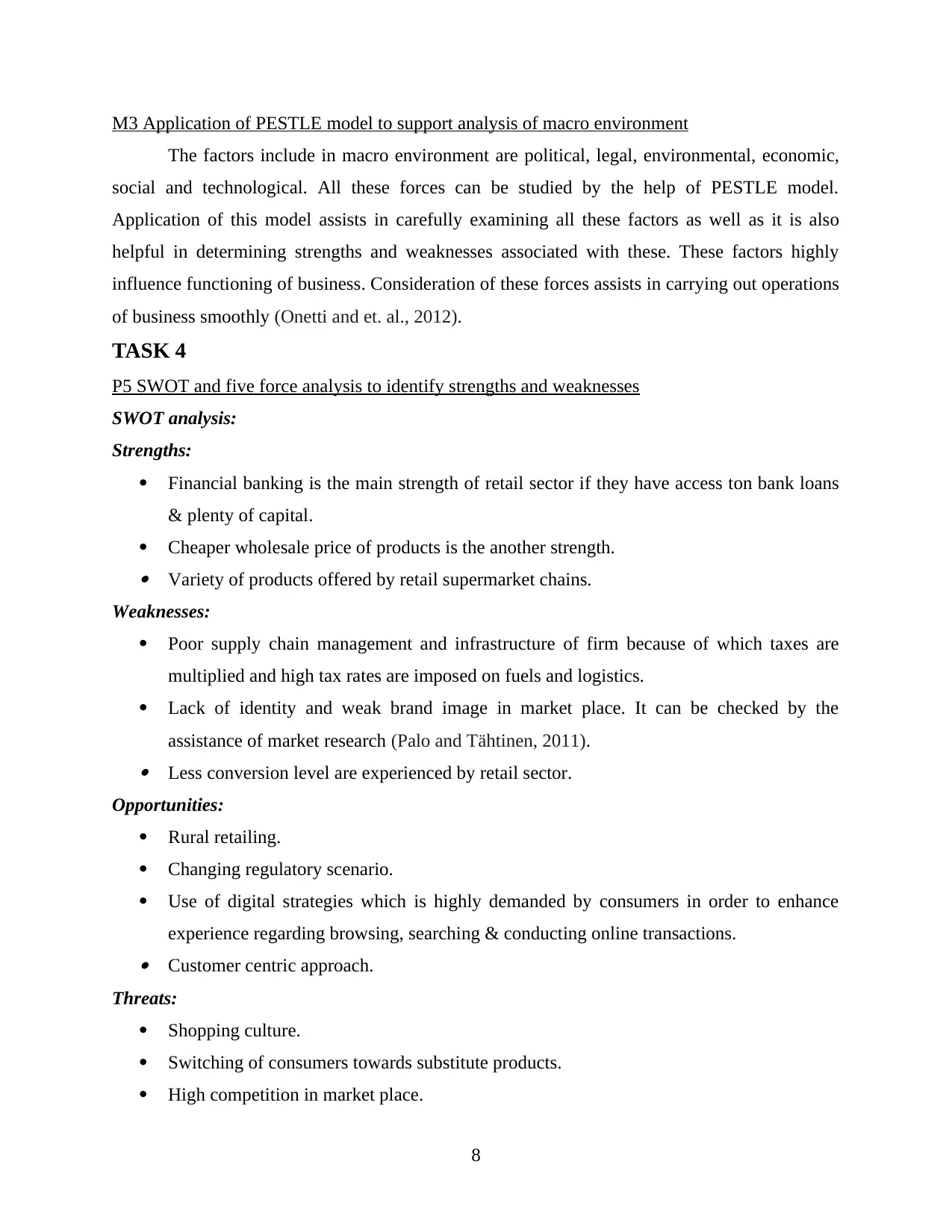
M3 Application of PESTLE model to support analysis of macro environment
The factors include in macro environment are political, legal, environmental, economic,
social and technological. All these forces can be studied by the help of PESTLE model.
Application of this model assists in carefully examining all these factors as well as it is also
helpful in determining strengths and weaknesses associated with these. These factors highly
influence functioning of business. Consideration of these forces assists in carrying out operations
of business smoothly (Onetti and et. al., 2012).
TASK 4
P5 SWOT and five force analysis to identify strengths and weaknesses
SWOT analysis:
Strengths:
Financial banking is the main strength of retail sector if they have access ton bank loans
& plenty of capital.
Cheaper wholesale price of products is the another strength. Variety of products offered by retail supermarket chains.
Weaknesses:
Poor supply chain management and infrastructure of firm because of which taxes are
multiplied and high tax rates are imposed on fuels and logistics.
Lack of identity and weak brand image in market place. It can be checked by the
assistance of market research (Palo and Tähtinen, 2011). Less conversion level are experienced by retail sector.
Opportunities:
Rural retailing.
Changing regulatory scenario.
Use of digital strategies which is highly demanded by consumers in order to enhance
experience regarding browsing, searching & conducting online transactions. Customer centric approach.
Threats:
Shopping culture.
Switching of consumers towards substitute products.
High competition in market place.
8
The factors include in macro environment are political, legal, environmental, economic,
social and technological. All these forces can be studied by the help of PESTLE model.
Application of this model assists in carefully examining all these factors as well as it is also
helpful in determining strengths and weaknesses associated with these. These factors highly
influence functioning of business. Consideration of these forces assists in carrying out operations
of business smoothly (Onetti and et. al., 2012).
TASK 4
P5 SWOT and five force analysis to identify strengths and weaknesses
SWOT analysis:
Strengths:
Financial banking is the main strength of retail sector if they have access ton bank loans
& plenty of capital.
Cheaper wholesale price of products is the another strength. Variety of products offered by retail supermarket chains.
Weaknesses:
Poor supply chain management and infrastructure of firm because of which taxes are
multiplied and high tax rates are imposed on fuels and logistics.
Lack of identity and weak brand image in market place. It can be checked by the
assistance of market research (Palo and Tähtinen, 2011). Less conversion level are experienced by retail sector.
Opportunities:
Rural retailing.
Changing regulatory scenario.
Use of digital strategies which is highly demanded by consumers in order to enhance
experience regarding browsing, searching & conducting online transactions. Customer centric approach.
Threats:
Shopping culture.
Switching of consumers towards substitute products.
High competition in market place.
8
Paraphrase This Document
Need a fresh take? Get an instant paraphrase of this document with our AI Paraphraser
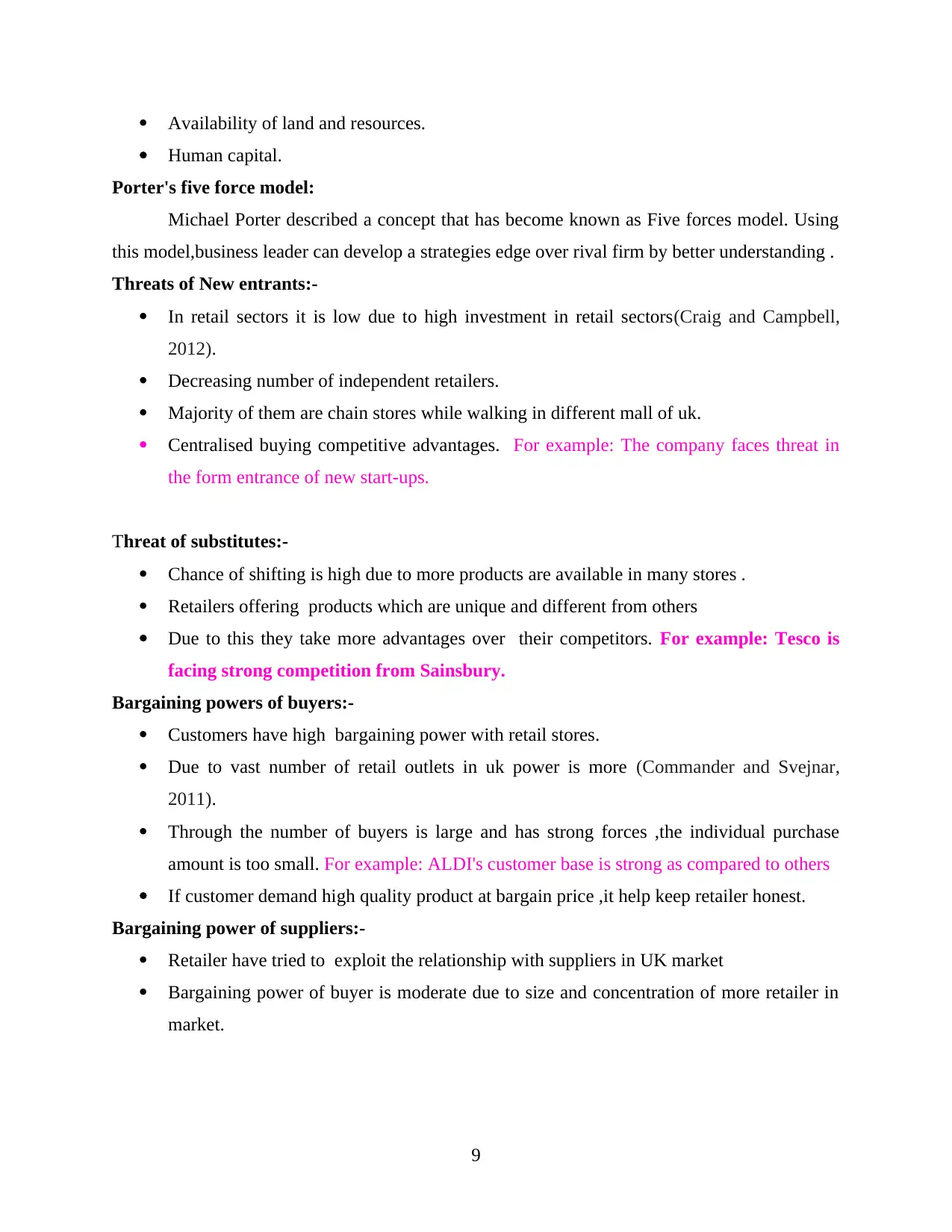
Availability of land and resources.
Human capital.
Porter's five force model:
Michael Porter described a concept that has become known as Five forces model. Using
this model,business leader can develop a strategies edge over rival firm by better understanding .
Threats of New entrants:-
In retail sectors it is low due to high investment in retail sectors(Craig and Campbell,
2012).
Decreasing number of independent retailers.
Majority of them are chain stores while walking in different mall of uk.
Centralised buying competitive advantages. For example: The company faces threat in
the form entrance of new start-ups.
Threat of substitutes:-
Chance of shifting is high due to more products are available in many stores .
Retailers offering products which are unique and different from others
Due to this they take more advantages over their competitors. For example: Tesco is
facing strong competition from Sainsbury.
Bargaining powers of buyers:-
Customers have high bargaining power with retail stores.
Due to vast number of retail outlets in uk power is more (Commander and Svejnar,
2011).
Through the number of buyers is large and has strong forces ,the individual purchase
amount is too small. For example: ALDI's customer base is strong as compared to others
If customer demand high quality product at bargain price ,it help keep retailer honest.
Bargaining power of suppliers:-
Retailer have tried to exploit the relationship with suppliers in UK market
Bargaining power of buyer is moderate due to size and concentration of more retailer in
market.
9
Human capital.
Porter's five force model:
Michael Porter described a concept that has become known as Five forces model. Using
this model,business leader can develop a strategies edge over rival firm by better understanding .
Threats of New entrants:-
In retail sectors it is low due to high investment in retail sectors(Craig and Campbell,
2012).
Decreasing number of independent retailers.
Majority of them are chain stores while walking in different mall of uk.
Centralised buying competitive advantages. For example: The company faces threat in
the form entrance of new start-ups.
Threat of substitutes:-
Chance of shifting is high due to more products are available in many stores .
Retailers offering products which are unique and different from others
Due to this they take more advantages over their competitors. For example: Tesco is
facing strong competition from Sainsbury.
Bargaining powers of buyers:-
Customers have high bargaining power with retail stores.
Due to vast number of retail outlets in uk power is more (Commander and Svejnar,
2011).
Through the number of buyers is large and has strong forces ,the individual purchase
amount is too small. For example: ALDI's customer base is strong as compared to others
If customer demand high quality product at bargain price ,it help keep retailer honest.
Bargaining power of suppliers:-
Retailer have tried to exploit the relationship with suppliers in UK market
Bargaining power of buyer is moderate due to size and concentration of more retailer in
market.
9
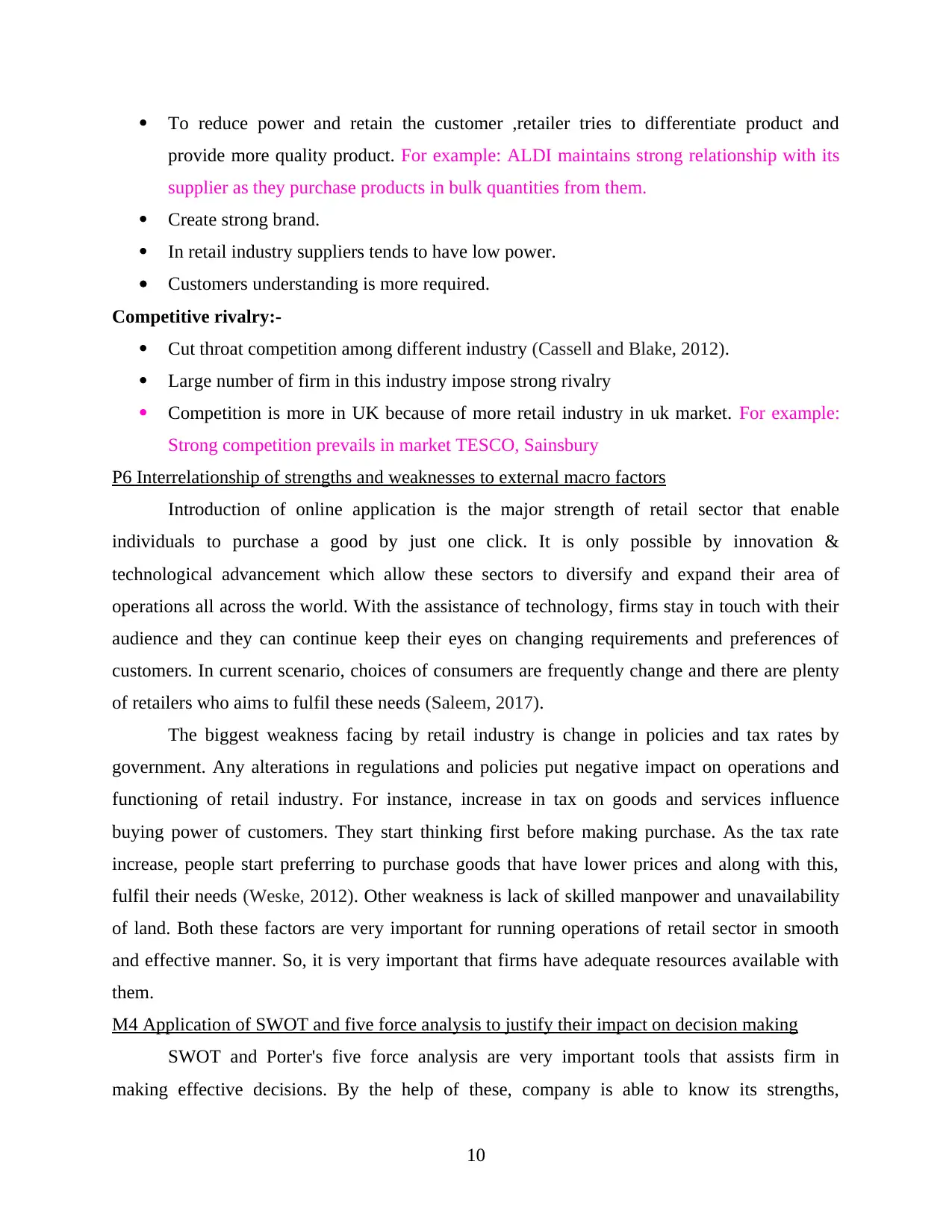
To reduce power and retain the customer ,retailer tries to differentiate product and
provide more quality product. For example: ALDI maintains strong relationship with its
supplier as they purchase products in bulk quantities from them.
Create strong brand.
In retail industry suppliers tends to have low power.
Customers understanding is more required.
Competitive rivalry:-
Cut throat competition among different industry (Cassell and Blake, 2012).
Large number of firm in this industry impose strong rivalry
Competition is more in UK because of more retail industry in uk market. For example:
Strong competition prevails in market TESCO, Sainsbury
P6 Interrelationship of strengths and weaknesses to external macro factors
Introduction of online application is the major strength of retail sector that enable
individuals to purchase a good by just one click. It is only possible by innovation &
technological advancement which allow these sectors to diversify and expand their area of
operations all across the world. With the assistance of technology, firms stay in touch with their
audience and they can continue keep their eyes on changing requirements and preferences of
customers. In current scenario, choices of consumers are frequently change and there are plenty
of retailers who aims to fulfil these needs (Saleem, 2017).
The biggest weakness facing by retail industry is change in policies and tax rates by
government. Any alterations in regulations and policies put negative impact on operations and
functioning of retail industry. For instance, increase in tax on goods and services influence
buying power of customers. They start thinking first before making purchase. As the tax rate
increase, people start preferring to purchase goods that have lower prices and along with this,
fulfil their needs (Weske, 2012). Other weakness is lack of skilled manpower and unavailability
of land. Both these factors are very important for running operations of retail sector in smooth
and effective manner. So, it is very important that firms have adequate resources available with
them.
M4 Application of SWOT and five force analysis to justify their impact on decision making
SWOT and Porter's five force analysis are very important tools that assists firm in
making effective decisions. By the help of these, company is able to know its strengths,
10
provide more quality product. For example: ALDI maintains strong relationship with its
supplier as they purchase products in bulk quantities from them.
Create strong brand.
In retail industry suppliers tends to have low power.
Customers understanding is more required.
Competitive rivalry:-
Cut throat competition among different industry (Cassell and Blake, 2012).
Large number of firm in this industry impose strong rivalry
Competition is more in UK because of more retail industry in uk market. For example:
Strong competition prevails in market TESCO, Sainsbury
P6 Interrelationship of strengths and weaknesses to external macro factors
Introduction of online application is the major strength of retail sector that enable
individuals to purchase a good by just one click. It is only possible by innovation &
technological advancement which allow these sectors to diversify and expand their area of
operations all across the world. With the assistance of technology, firms stay in touch with their
audience and they can continue keep their eyes on changing requirements and preferences of
customers. In current scenario, choices of consumers are frequently change and there are plenty
of retailers who aims to fulfil these needs (Saleem, 2017).
The biggest weakness facing by retail industry is change in policies and tax rates by
government. Any alterations in regulations and policies put negative impact on operations and
functioning of retail industry. For instance, increase in tax on goods and services influence
buying power of customers. They start thinking first before making purchase. As the tax rate
increase, people start preferring to purchase goods that have lower prices and along with this,
fulfil their needs (Weske, 2012). Other weakness is lack of skilled manpower and unavailability
of land. Both these factors are very important for running operations of retail sector in smooth
and effective manner. So, it is very important that firms have adequate resources available with
them.
M4 Application of SWOT and five force analysis to justify their impact on decision making
SWOT and Porter's five force analysis are very important tools that assists firm in
making effective decisions. By the help of these, company is able to know its strengths,
10
⊘ This is a preview!⊘
Do you want full access?
Subscribe today to unlock all pages.

Trusted by 1+ million students worldwide
1 out of 15
Related Documents
Your All-in-One AI-Powered Toolkit for Academic Success.
+13062052269
info@desklib.com
Available 24*7 on WhatsApp / Email
![[object Object]](/_next/static/media/star-bottom.7253800d.svg)
Unlock your academic potential
Copyright © 2020–2025 A2Z Services. All Rights Reserved. Developed and managed by ZUCOL.





